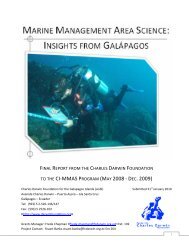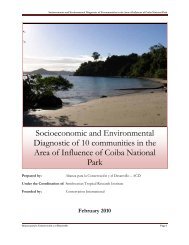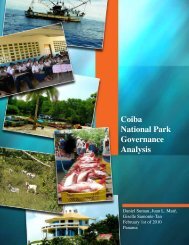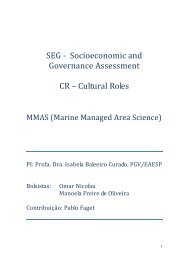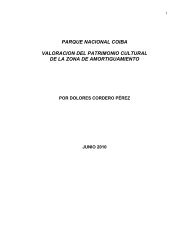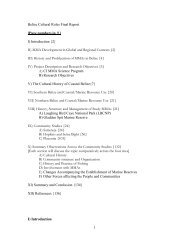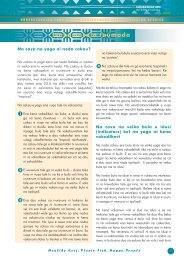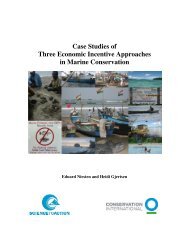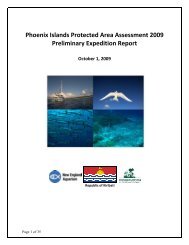Economic Values of Coral Reefs, Mangroves, and Seagrasses A ...
Economic Values of Coral Reefs, Mangroves, and Seagrasses A ...
Economic Values of Coral Reefs, Mangroves, and Seagrasses A ...
Create successful ePaper yourself
Turn your PDF publications into a flip-book with our unique Google optimized e-Paper software.
Section 2: Ecosystem Goods <strong>and</strong> Services <strong>Values</strong><br />
A 2002 study analyzed the costs <strong>and</strong> benefits <strong>of</strong> coral mining in Lombok,<br />
Indonesia, looking at the societal costs <strong>of</strong> this activity associated with<br />
losses to typical reef functions. The economic valuation presented two<br />
scenarios: one with limited tourism potential <strong>and</strong> little coastal construction<br />
(scenario ‘LOW’), <strong>and</strong> the other with high tourism potential <strong>and</strong><br />
considerable coastal infrastructure (scenario ‘HIGH’). All costs were calculated<br />
in net present value terms (the discounted sum <strong>of</strong> annual costs)<br />
for a 30-year time horizon. The net loss <strong>of</strong> the tourism function was<br />
valued at $2,900 for the ‘LOW’ scenario <strong>and</strong> $481,900 for the ‘HIGH’<br />
scenario (Cesar, 2002).<br />
Eco-tourist revenues generated by the coral reefs in Indonesia’s Wakatobi<br />
National Park in Southeast Sulawesi provided almost $1,320 per km²<br />
in 2004 <strong>and</strong> an expected present value <strong>of</strong> $286,000 (Hargreaves-Allen,<br />
2004).<br />
The Willingness To Pay (WTP) to access the Pulau Payar Marine Park,<br />
Malaysia, was elicited in 1998. The study found that 91% <strong>of</strong> respondents<br />
would accept an entrance fee. The average WTP was estimated at<br />
$4.20. In terms <strong>of</strong> the tourist numbers recorded during the year <strong>of</strong> the<br />
study, this estimate reflected a potential recreational value <strong>of</strong> the reefs in<br />
the park <strong>of</strong> $390,000 per year (Yeo, 2004).<br />
A study estimated that the economic value <strong>of</strong> recreational resources <strong>of</strong><br />
Pulau Redang Marine Park, Malaysia, based on willingness to pay per<br />
visit responses, ranged from $3.00 to $4.40. If collected, this would have<br />
contributed between $373,900 <strong>and</strong> $545,100 in park management funds<br />
in 2005 (Mohd Parid, Lim <strong>and</strong> Woon, 2005).<br />
A 2007 contingent valuation study found that ecotourism to see whale<br />
sharks in the Bahia de los Ángeles, Mexico, could be an important source<br />
<strong>of</strong> income (between $78,030 <strong>and</strong> $111,843 per year) for the 700 residents<br />
living around the bay (Low-Pfeng, de la Cuera <strong>and</strong> Enríquez, 2005).<br />
Tourism accounted for 44% <strong>of</strong> the total net benefits <strong>of</strong> the $11.5 million<br />
provided by the Bohol Marine Triangle in the Philippines (Samonte-Tan<br />
et al., 2007).<br />
Using the travel cost method, a study evaluated recreational benefits<br />
<strong>of</strong> coral reefs along the Lingayen Gulf, Bolinao, Philippines. Empirical<br />
results generated consumer surplus valued at (Philippine peso)<br />
PhP10,463 ($223) per person per annum or potential net annual revenues<br />
14<br />
To view or contribute additional case studies, go to www.consvalmap.org



